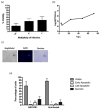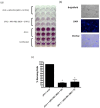Replication and Oncolytic Activity of an Avian Orthoreovirus in Human Hepatocellular Carcinoma Cells
- PMID: 28441762
- PMCID: PMC5408696
- DOI: 10.3390/v9040090
Replication and Oncolytic Activity of an Avian Orthoreovirus in Human Hepatocellular Carcinoma Cells
Abstract
Oncolytic viruses are cancer therapeutics with promising outcomes in pre-clinical and clinical settings. Animal viruses have the possibility to avoid pre-existing immunity in humans, while being safe and immunostimulatory. We isolated an avian orthoreovirus (ARV-PB1), and tested it against a panel of hepatocellular carcinoma cells. We found that ARV-PB1 replicated well and induced strong cytopathic effects. It was determined that one mechanism of cell death was through syncytia formation, resulting in apoptosis and induction of interferon stimulated genes (ISGs). As hepatitis C virus (HCV) is a major cause of hepatocellular carcinoma worldwide, we investigated the effect of ARV-PB1 against cells already infected with this virus. Both HCV replicon-containing and infected cells supported ARV-PB1 replication and underwent cytolysis. Finally, we generated in silico models to compare the structures of human reovirus- and ARV-PB1-derived S1 proteins, which are the primary targets of neutralizing antibodies. Tertiary alignments confirmed that ARV-PB1 differs from its human homolog, suggesting that immunity to human reoviruses would not be a barrier to its use. Therefore, ARV-PB1 can potentially expand the repertoire of oncolytic viruses for treatment of human hepatocellular carcinoma and other malignancies.
Keywords: avian orthoreovirus; hepatitis C virus; hepatocellular carcinoma; oncolytic virus; syncytia.
Conflict of interest statement
The authors declare no conflict of interest.
Figures










Similar articles
-
Oncolytic avian reovirus-sensitized tumor infiltrating CD8+ T cells triggering immunogenic apoptosis in gastric cancer.Cell Commun Signal. 2024 Oct 21;22(1):514. doi: 10.1186/s12964-024-01888-0. Cell Commun Signal. 2024. PMID: 39434159 Free PMC article.
-
Response of Three Different Viruses to Interferon Priming and Dithiothreitol Treatment of Avian Cells.J Virol. 2016 Aug 26;90(18):8328-40. doi: 10.1128/JVI.01175-16. Print 2016 Sep 15. J Virol. 2016. PMID: 27440902 Free PMC article.
-
Oncolytic Reoviruses: Can These Emerging Zoonotic Reoviruses Be Tamed and Utilized?DNA Cell Biol. 2023 Jun;42(6):289-304. doi: 10.1089/dna.2022.0561. Epub 2023 Apr 4. DNA Cell Biol. 2023. PMID: 37015068 Review.
-
Mycophenolic acid inhibits avian reovirus replication.Antiviral Res. 2004 Oct;64(1):55-61. doi: 10.1016/j.antiviral.2004.05.004. Antiviral Res. 2004. PMID: 15451179
-
Avian reovirus: structure and biology.Virus Res. 2007 Feb;123(2):105-19. doi: 10.1016/j.virusres.2006.09.005. Epub 2006 Oct 2. Virus Res. 2007. PMID: 17018239 Review.
Cited by
-
Oncolytic Avian Reovirus σA-Modulated Upregulation of the HIF-1α/C-myc/glut1 Pathway to Produce More Energy in Different Cancer Cell Lines Benefiting Virus Replication.Viruses. 2023 Feb 13;15(2):523. doi: 10.3390/v15020523. Viruses. 2023. PMID: 36851737 Free PMC article.
-
Role of Myeloid Cells in Oncolytic Reovirus-Based Cancer Therapy.Viruses. 2021 Apr 10;13(4):654. doi: 10.3390/v13040654. Viruses. 2021. PMID: 33920168 Free PMC article. Review.
-
Oncolytic Viruses: Immunotherapy Drugs for Gastrointestinal Malignant Tumors.Front Cell Infect Microbiol. 2022 Jun 3;12:921534. doi: 10.3389/fcimb.2022.921534. eCollection 2022. Front Cell Infect Microbiol. 2022. PMID: 35719333 Free PMC article. Review.
-
The Oncolytic Avian Reovirus p17 Protein Inhibits Invadopodia Formation in Murine Melanoma Cancer Cells by Suppressing the FAK/Src Pathway and the Formation of theTKs5/NCK1 Complex.Viruses. 2024 Jul 17;16(7):1153. doi: 10.3390/v16071153. Viruses. 2024. PMID: 39066315 Free PMC article.
-
Oncolytic Avian Reovirus p17-Modulated Inhibition of mTORC1 by Enhancement of Endogenous mTORC1 Inhibitors Binding to mTORC1 To Disrupt Its Assembly and Accumulation on Lysosomes.J Virol. 2022 Sep 14;96(17):e0083622. doi: 10.1128/jvi.00836-22. Epub 2022 Aug 10. J Virol. 2022. PMID: 35946936 Free PMC article.
References
Publication types
MeSH terms
Substances
LinkOut - more resources
Full Text Sources
Other Literature Sources
Research Materials
Miscellaneous

